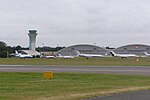1952 Farnborough Airshow crash

On 6 September 1952, a prototype de Havilland DH.110 jet fighter crashed during an aerial display at the Farnborough Airshow in Hampshire, England. The jet disintegrated mid-air during an aerobatic manoeuvre, causing the death of pilot John Derry and onboard flight test observer Anthony Richards. Debris from the aircraft fell onto a crowd of spectators, killing 29 people and injuring 60.The cause of the break-up was later determined to be structural failure due to a design flaw in the wing's leading edge. All DH.110s were initially grounded, but after modification to its design, the type entered service with the Royal Navy as the Sea Vixen. Stricter safety procedures were subsequently enacted for UK air shows and there were no further spectator fatalities until the 2015 Shoreham Airshow crash in which 11 people died.
Excerpt from the Wikipedia article 1952 Farnborough Airshow crash (License: CC BY-SA 3.0, Authors, Images).1952 Farnborough Airshow crash
Barracuda Road, Rushmoor
Geographical coordinates (GPS) Address Nearby Places Show on map
Geographical coordinates (GPS)
| Latitude | Longitude |
|---|---|
| N 51.275833333333 ° | E -0.77638888888889 ° |
Address
South Apron
Barracuda Road
GU11 2HH Rushmoor
England, United Kingdom
Open on Google Maps




